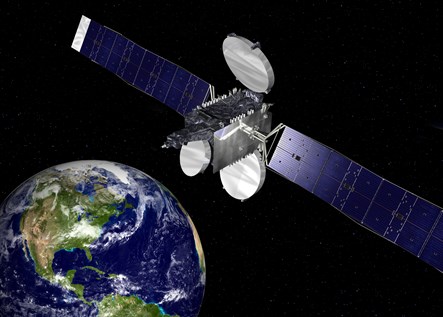Radio Frequency Interference
Radio frequency (RF) communications are essential to satellites. As part of the electromagnetic spectrum, radio waves are used by satellite to receive commands from ground controllers (uplink) and relay information about their health and status in return (downlink). Many satellites also use radio waves as an important element in their functioning, including retransmitting television broadcasts or transmitting imagery or scientific data that they have collected. Unintentional RF interference can arise from a number of sources. Natural interference can be caused by solar storms and other forms of space weather, interaction with the Earth’s atmosphere, and sometimes even clouds and rain. Unintentional manmade interference can result from a satellite transmitting too close to another satellite on the same frequency or from terrestrial communications systems operating on the same or similar frequency to space systems.
Intentional RF interference, often referred to as jamming, is a way of temporarily or reversibly disrupting the normal functioning of a satellite without resorting to actual destruction of the satellite and the chance of creating long-lived space debris. Intentional interference is also relatively easy to accomplish, often requiring nothing more than an antenna and a transmitter. Applications for jamming range from blocking undesirable radio and television broadcasts from being transmitted into a country to blocking satellite navigation signals to prevent an employer from tracking movements, to degrading the ability of an adversary to use precision munitions, among others.
International and national mechanisms currently exist to regulate RF communications. However, these mechanisms focus more on the allocation of spectrum and assignment of frequencies than on the prevention of interference. They also lack enforcement powers. As the instances of unintentional and intentional RF interference increase due to crowding and congestion on orbit, these regulatory shortcomings present a significant challenge to the long-term sustainable use of space.
Galaxy 15 "Zombiesat" - April to December - 2010
- In April 2010, a malfunction caused Intelsat S.A. to lose contact with Galaxy 15, a geosynchronous satellite that provided communications services over the Americas
- The malfunction prevented Intelsat from maneuvering Galaxy 15, and the spacecraft started to drift slowly past other operational satellites in the region
- Galaxy 15's receiver and transmitter equipment was still functioning, meaning it could pick up and re-broadcast signals aimed at other satellites as it drifted past, potentially causing serious radio frequency interference
- Ultimately, Intelsat was able to regain control of Galaxy 15, but only the close communication and cooperation between satellite operators prevented any significant harmful effects
 Artist's rendering of the Galaxy 15 satellite. Courtesy of Intelsat
Artist's rendering of the Galaxy 15 satellite. Courtesy of Intelsat

 Share
Share